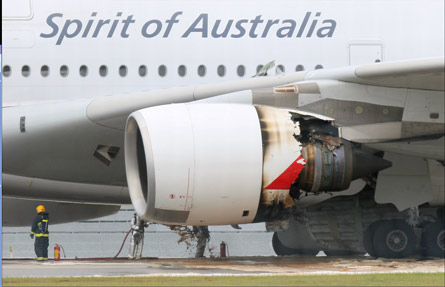The Australian Transport and Safety Bureau (ATSB) has detailed the reasons behind the uncontained failure of a Rolls-Royce Trent 900 engine, which forced a Qantas Airways Airbus A380 to make an emergency landing in November.
The ATSB has also recommended an additional one-off inspection within two flight cycles, after an examination of the failed engines components at the Rolls-Royce plants in Derby. This applies to all "relevant" variants of the Trent 900 engine.
In the first public details about the likely cause of the 4 November incident, the ATSB says that there was "fatigue cracking" within a stub pipe that feeds oil into the High Pressure (HP)/Intermediate Pressure (IP) bearing structure. This led to an oil leakage, and subsequently an oil fire and the engine failure, it adds.
"While the analysis of the engine failure is ongoing, it has been identified that the leakage of oil into the HP/IP bearing structure buffer space, and a subsequent oil fire within that area, was central to the engine failure and IP turbine disc liberation event," it adds.
"Further examination of the cracked area has identified the axial misalignment of an area of counter-boring within the inner diameter of the stub pipe; the misalignment having produced a localised thinning of the pipe wall on one side. The area of fatigue cracking was associated with the area of pipe wall thinning."

The failure led to the Qantas A380 losing part of its engine cowling and other components, and damaged its wing, shortly after take-off from Singapore. The pilots made an emergency landing at the same airport.
Both Qantas and Singapore Airlines, which also operates A380s powered by the Trent 900 engines, temporarily grounded their aircraft as a result. SIA resumed services soon after the European Aviation Safety Agency (EASA) issued guidelines for additional inspections, and Qantas resumed A380 flights last week.
The ATSB, after discussions with Qantas, Rolls-Royce and the Civil Aviation Safety Authority (CASA), has recommended a more detailed one-off inspection of Trent 900 engines following the latest findings. These should be conducted within two flight cycles, which is above the 20 cycle inspection mandated by EASA after the first incident.
The findings apply to all "relevant" variants of the Trent 900 engine operated worldwide. This means that SIA and Lufthansa, which also operates A380s powered by the engines, will be affected.
"We have begun the inspections and are complying with the recommendations, which are intended to ensure the continued safe operation of the fleet," says SIA.
Qantas, which has returned two A380s to service, says that it will begin the inspections at its maintenance facility in Sydney this afternoon. It does not anticipate any impact on international services at this stage.
"Qantas will determine any further response after it has finalised the inspection regime and consulted with both regulators and the manufacturer," adds the Oneworld carrier.
Source: Air Transport Intelligence news



















